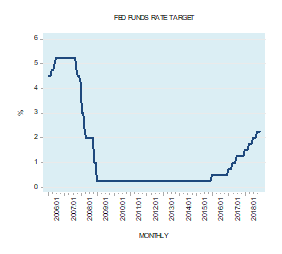In his speech to the Economic Club of New York on November 28 2018, the Federal Reserve Board Chairman Jerome Powell said that the US central bank’s policy interest rate is just below the neutral rate. This prompted many commentators to suggest that a tighter interest rate stance of the Fed is likely coming to an end. At the end of October the fed funds rate target stood at 2.25%.
|
|
It is widely held that by means of suitable monetary policies the US central bank can navigate the economy towards a growth path of economic stability and prosperity. The key ingredient in achieving this is price stability. Most experts are of the view that what prevents the attainment of price stability are the fluctuations of the federal funds rate around the neutral rate of interest.
The neutral rate, it is held, is one that is consistent with stable prices and a balanced economy. What is required is Fed policy makers successfully targeting the federal funds rate towards the neutral interest rate.
The Swedish economist Knut Wicksell articulated this framework of thinking in late 19th century, which has its origins in the 18th century writings of British economist Henry Thornton.
The Neutral Interest Rate Framework
According to Wicksell, there is a certain rate of interest on loans, which is neutral in respect to commodity prices, and tend neither to raise nor to lower them.
According to this view, the main source of economic instability is the variance between the money market interest rate and the neutral rate.
If the money market rate falls below the neutral rate, investment will exceed saving implying that aggregate demand will be greater than aggregate supply.
…click on the above link to read the rest of the article…
